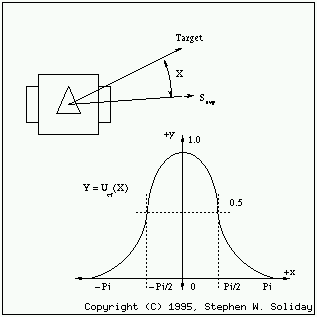
Figure 13.7: Membership in Edge-follow

The controller itself is based on determining whether of not the target is obstructed. The concepts of converting from fuzzy to crisp were used to determine the most probable direction of the closest obstruction. This direction was then compared to the actual direction of the target.
The decision to edge-follow or goal-seek is not a crisp A or B decision. Rather, the decision is fuzzy-parametric. Using a fuzzy set to determine the membership of OBSTRUCTED, a parametric equation could be used to determine how much of A or how much of B to pass to the output.
The basic parametric equation is defined as:

The column vectors (A) and (B) represent two end point vectors describing some set of coordinates or parameters. The output vector (X) morphs from (A) to (B) in a linear fashion as the parametric pointer (t) moves from 0 to 1.
A circular universe of discourse was created by centering a Gaussian like membership function at the angle of each sensor. The width of these membership functions is such the the membership is (1/2) at the midpoint between two sensors. Using a center of mass equation, where the sensor angles are the centers and the memberships are the weights, a ``most probable'' direction of the nearest obstruction is determined.
As discussed above, the subsystem receives input pairs (velocity and heading) and parametrically sums both vectors to produce an output.

Where $\mu$ is the membership function described in Figure 13.7

As can be seen by examining Figure 13.7 and
the last equation, if the target heading and the obstruction heading
are in conjunction with the vehicle, then the output will be due to the
edge-following input only.
If the target heading and the obstruction heading are in opposition with
the vehicle, however, the output will be due only to the goal-seeking
input.
This module is part of a robotics simulation that was demonstrated in
a Master's Thesis entitled:
A Subsystem Approach to Developing a Behavior Based
Hybrid Navigation System for Autonomous Vehicles